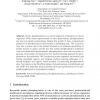Free Online Productivity Tools
i2Speak
i2Symbol
i2OCR
iTex2Img
iWeb2Print
iWeb2Shot
i2Type
iPdf2Split
iPdf2Merge
i2Bopomofo
i2Arabic
i2Style
i2Image
i2PDF
iLatex2Rtf
Sci2ools
BICOB
2009
Springer
2009
Springer
A New Machine Learning Approach for Protein Phosphorylation Site Prediction in Plants
Protein phosphorylation is a crucial regulatory mechanism in various organisms. With recent improvements in mass spectrometry, phosphorylation site data are rapidly accumulating. Despite this wealth of data, computational prediction of phosphorylation sites remains a challenging task. This is particularly true in plants, due to the limited information on substrate specificities of protein kinases in plants and the fact that current phosphorylation prediction tools are trained with kinase-specific phosphorylation data from non-plant organisms. In this paper, we proposed a new machine learning approach for phosphorylation site prediction. We incorporate protein sequence information and protein disordered regions, and integrate machine learning techniques of knearest neighbor and support vector machine for predicting phosphorylation sites. Test results on the PhosPhAt dataset of phosphoserines in Arabidopsis and the TAIR7 non-redundant protein database show good performance of our propose...
BICOB 2009 | Computational Biology | Phosphorylation | Phosphorylation Site | Phosphorylation Site Prediction |
| Added | 24 Jul 2010 |
| Updated | 24 Jul 2010 |
| Type | Conference |
| Year | 2009 |
| Where | BICOB |
| Authors | Jianjiong Gao, Ganesh Kumar Agrawal, Jay J. Thelen, Zoran Obradovic, A. Keith Dunker, Dong Xu |
Comments (0)

